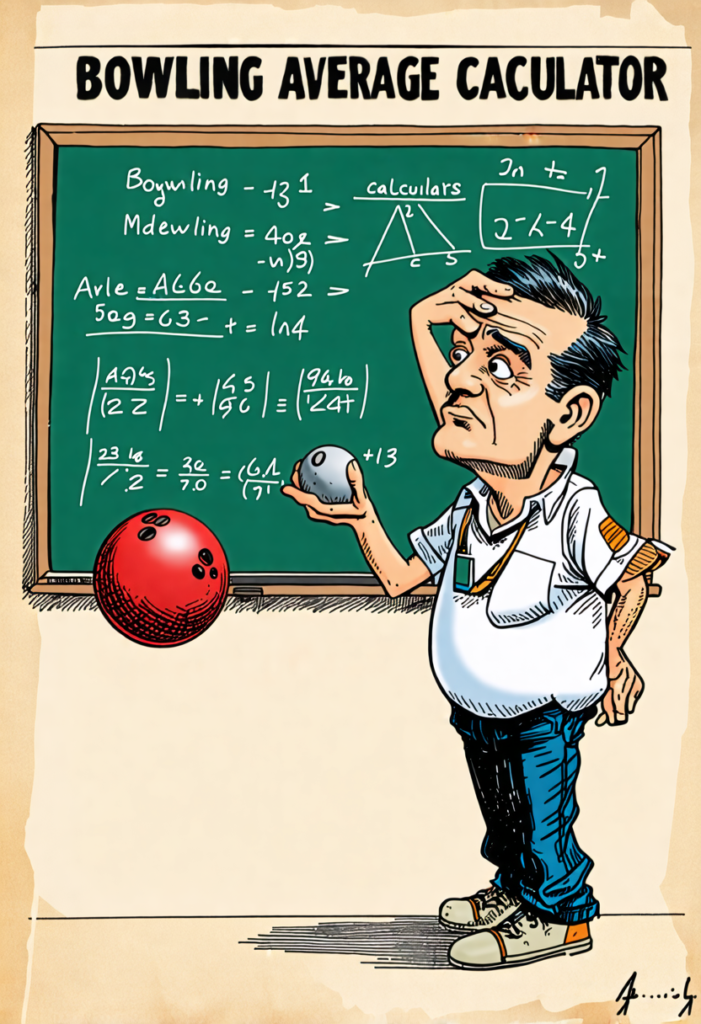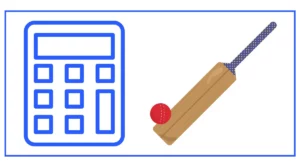Bowling Average Calculator
Bowling average:
Are you a cricketer? Do you want to calculate your bowling average? Or maybe you want an easy way to find the average of your favorite bowler.
This bowling average calculator allows you to find your bowling averages in no time.
Simply add the number of runs conceded and the number of wickets taken. Hit the calculate button. Voila!
Don’t worry, if your average is not up to the mark. Work hard and be a deadly opening bowler like Shaheen Shah or a death overs specialist like Bumrah.
Bookmark this page and come back after the next match to see the improvement!

What is a Bowling Average?
A bowling average is a key statistic used to assess a bowler’s performance in cricket. It represents the average number of runs conceded by a bowler for each wicket taken. The lower the bowling average, the better the bowler is considered to be performing.
How to Calculate Your Bowling Average
Calculating your bowling average is a straightforward process. Here’s the basic formula:
Bowling Average = Total Runs Conceded / Total Wickets Taken
For example, if a bowler has conceded 200 runs and taken 10 wickets, their bowling average would be:
200 / 10 = 20
This means the bowler, on average, concedes 20 runs for each wicket they take.
Using the Bowling Average Calculator
To make the calculation process easier, you can use the bowling average calculator provided above. Simply input the total runs conceded and the number of wickets taken, then click the “Calculate Bowling Average” button. The calculator will instantly provide your bowling average.
Interpreting Your Bowling Average
Understanding what your bowling average means is crucial for evaluating your performance as a bowler. Here’s a general guide:
- Below 20: Excellent
- 20-25: Very good
- 25-30: Good
- 30-35: Average
- Above 35: Below average
However, it’s important to note that these ranges can vary depending on the format of cricket being played (Test, One Day International, or Twenty20) and the conditions of the match.
Factors Affecting Bowling Average
Several factors can influence a bowler’s average:
- Pitch conditions
- Match format
- Quality of opposition
- Bowling style
- Field placements
For instance, a bowler might have a higher average in Test cricket compared to Twenty20 due to the different strategies employed in each format.
The Importance of Bowling Average in Cricket
The bowling average is one of the primary statistics used to compare bowlers across different eras and playing conditions. It provides a standardized metric that helps in:
- Player selection
- Strategy formulation
- Performance evaluation
- Historical comparisons
Coaches, selectors, and team captains often use bowling averages to make decisions about team composition and match strategy.
Limitations of Bowling Average
While the bowling average is a valuable statistic, it does have some limitations:
- It doesn’t account for the rate at which runs are conceded.
- It doesn’t reflect the match situation or the importance of wickets taken.
- It can be skewed by a small number of matches or innings.
Because of these limitations, cricket analysts often use bowling average in conjunction with other statistics like economy rate and strike rate for a more comprehensive evaluation.
Other Important Bowling Statistics in Cricket
While bowling average is crucial, other statistics are also used to evaluate a bowler’s performance:
Economy Rate
The economy rate measures the average number of runs a bowler concedes per over. It’s calculated by dividing the total runs conceded by the number of overs bowled.
Economy Rate = Runs Conceded / Overs Bowled
A lower economy rate indicates that a bowler is more effective at restricting runs.
Strike Rate
The bowling strike rate represents the average number of balls bowled per wicket taken. It’s calculated by dividing the number of balls bowled by the number of wickets taken.
Strike Rate = Balls Bowled / Wickets Taken
A lower strike rate suggests that a bowler takes wickets more frequently.
Famous Bowlers and Their Averages
To put bowling averages into perspective, let’s look at some of the best Test cricket bowlers of all time and their career bowling averages:
- Sydney Barnes (England): 16.43
- George Lohmann (England): 10.75
- Malcolm Marshall (West Indies): 20.94
- Joel Garner (West Indies): 20.97
- Curtly Ambrose (West Indies): 20.99
These extraordinary averages demonstrate why these players are considered among the greatest bowlers in cricket history.
Improving Your Bowling Average
If you’re a bowler looking to improve your average, consider these tips:
- Practice consistently to improve accuracy and control.
- Study the batsmen you’re facing to understand their weaknesses.
- Work on varying your pace and movement to keep batsmen guessing.
- Develop a repertoire of different deliveries.
- Stay fit to maintain your performance throughout long spells.
Remember, improving your bowling average is a gradual process that requires patience and dedication.
Bowling Average in Different Cricket Formats
It’s worth noting that bowling averages can vary significantly across different cricket formats:
Test Cricket
In Test cricket, bowling averages tend to be lower due to the longer format allowing bowlers more time to set up batsmen and take wickets. An average below 25 is considered excellent in Test cricket.
One Day International (ODI)
In ODIs, bowling averages are typically higher due to the more aggressive batting style. An average below 30 is considered very good in this format.
Twenty20 (T20)
T20 cricket often sees the highest bowling averages due to the aggressive nature of the game and the focus on run-scoring. In this format, an average below 25 is considered excellent.
Conclusion
Understanding and calculating your bowling average is essential for any cricket player or enthusiast. It provides valuable insights into a bowler’s performance and effectiveness on the field. While it’s not the only metric to consider, it remains one of the most important statistics in cricket.
By using the bowling average calculator provided and understanding the context behind the numbers, you can gain a deeper appreciation for the art of bowling in cricket. Whether you’re a player looking to improve your game, a coach evaluating talent, or a fan analyzing performances, the bowling average is a crucial tool in your cricket knowledge arsenal.






